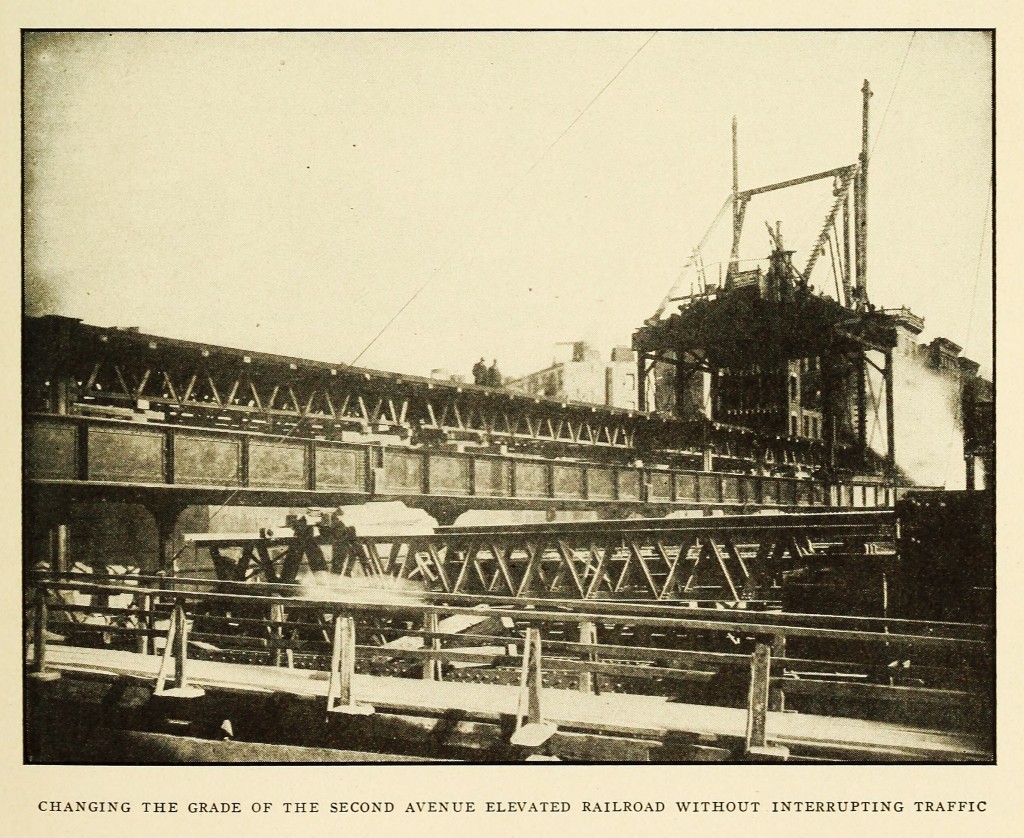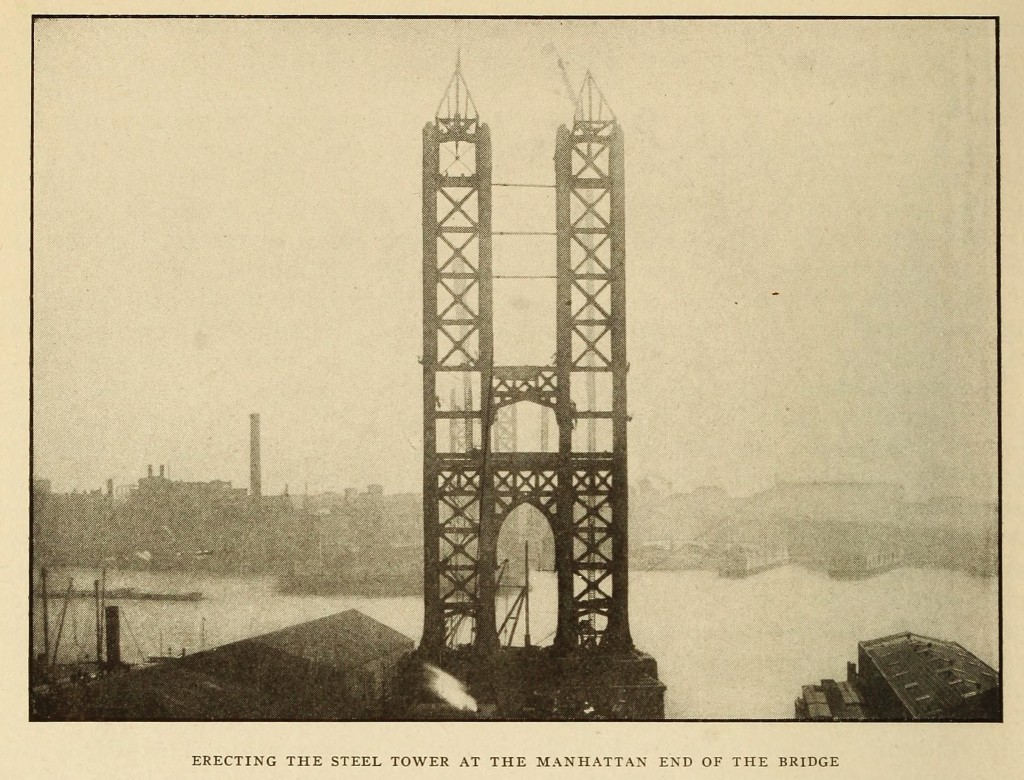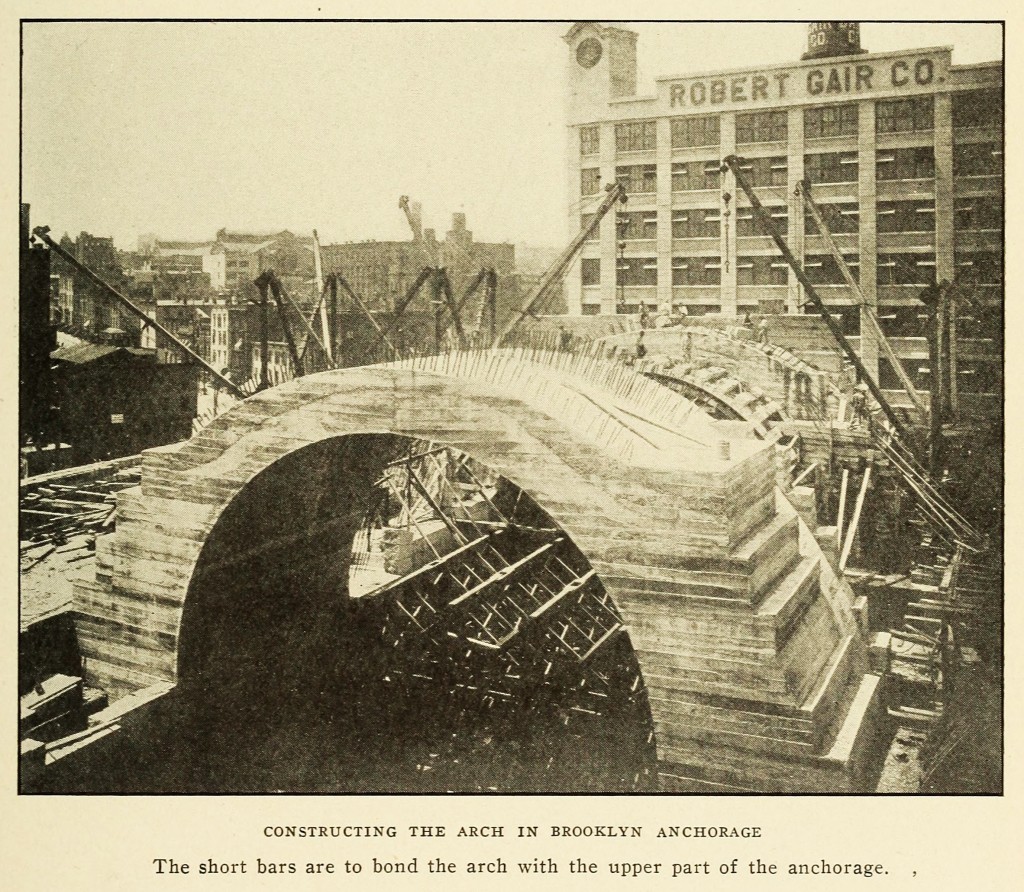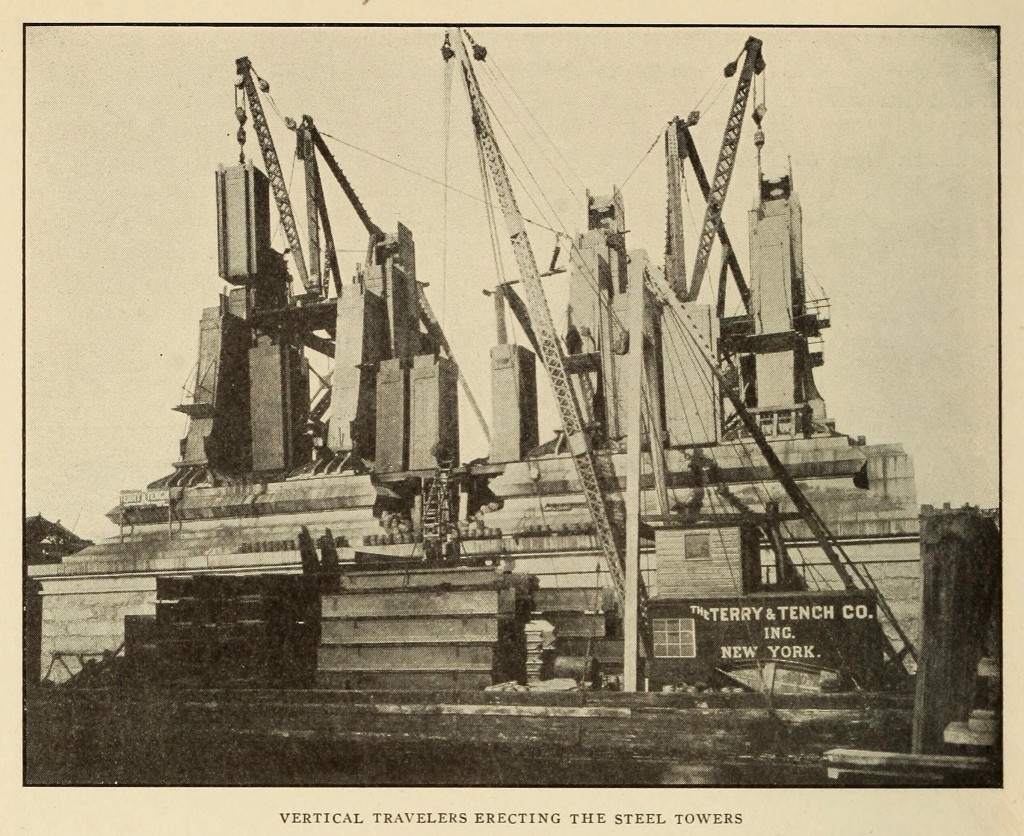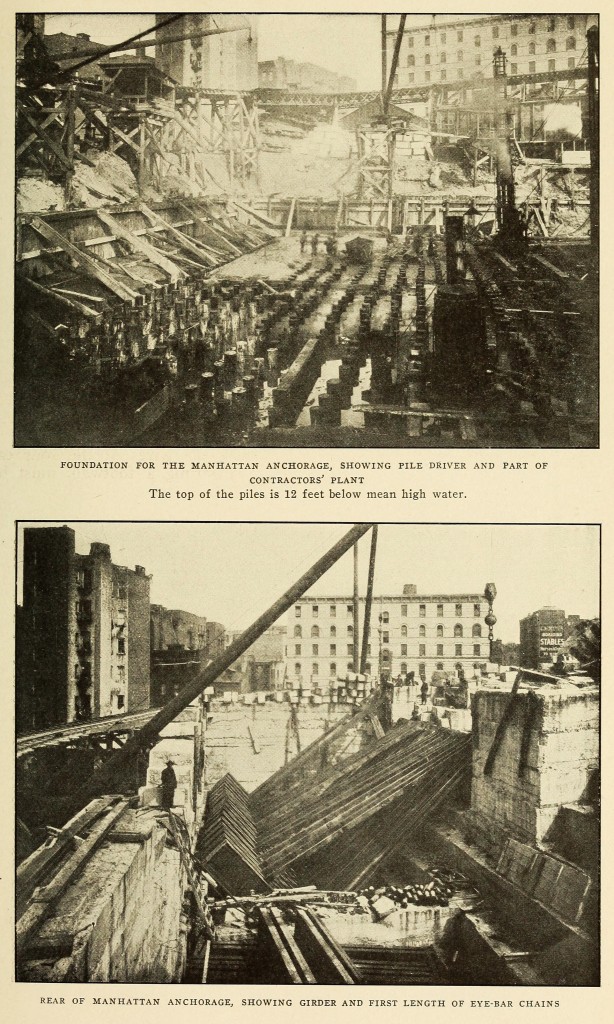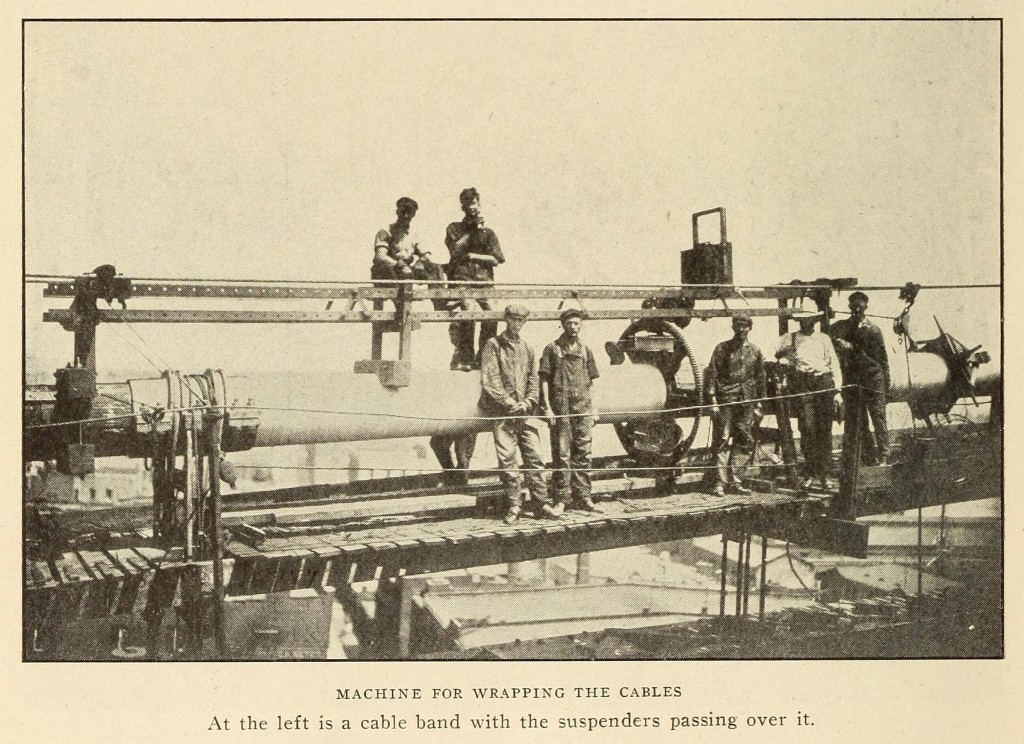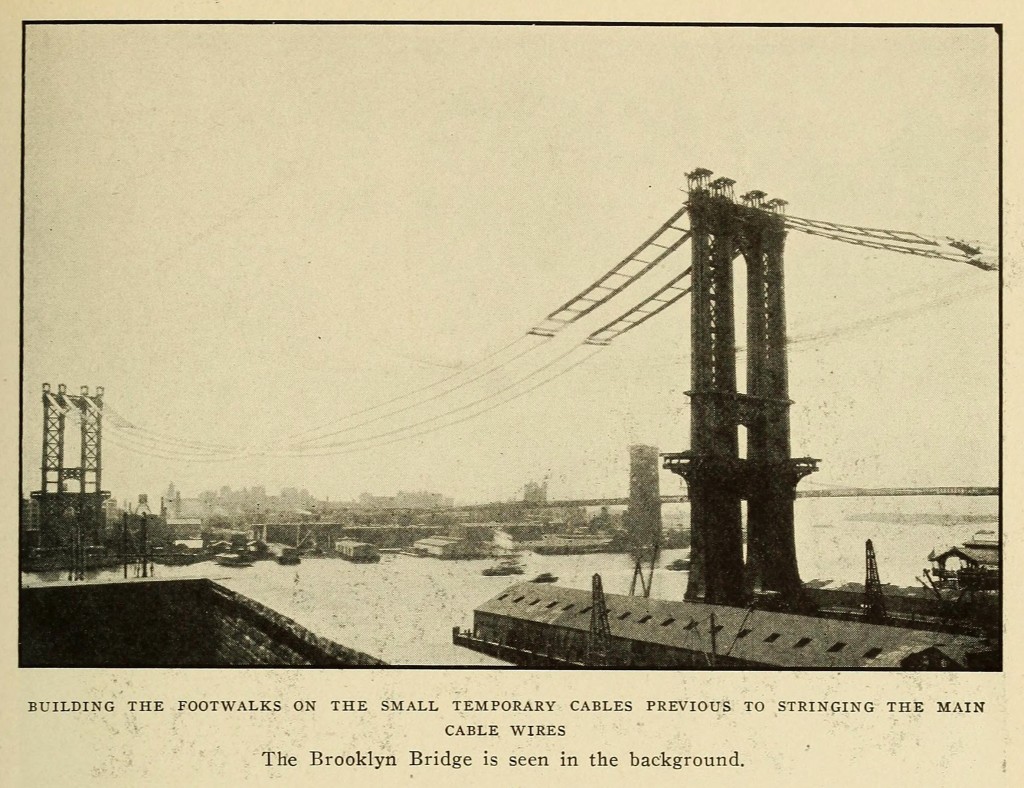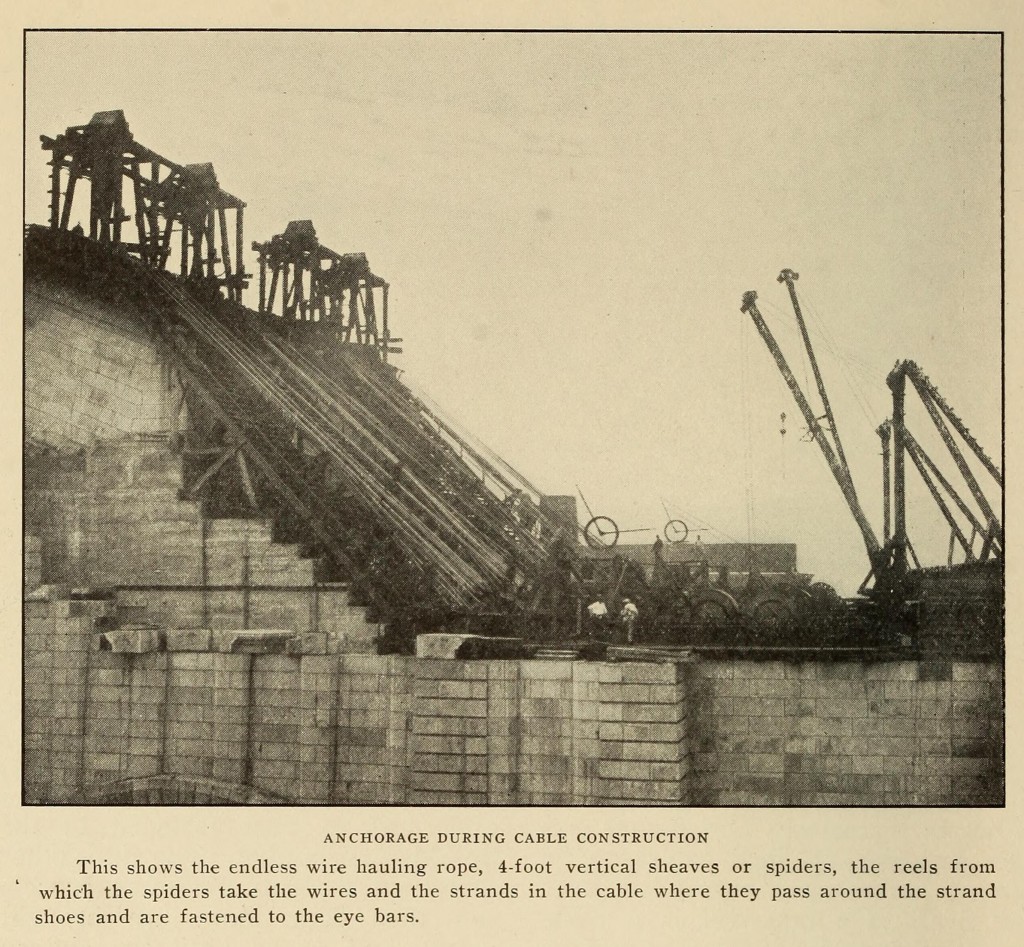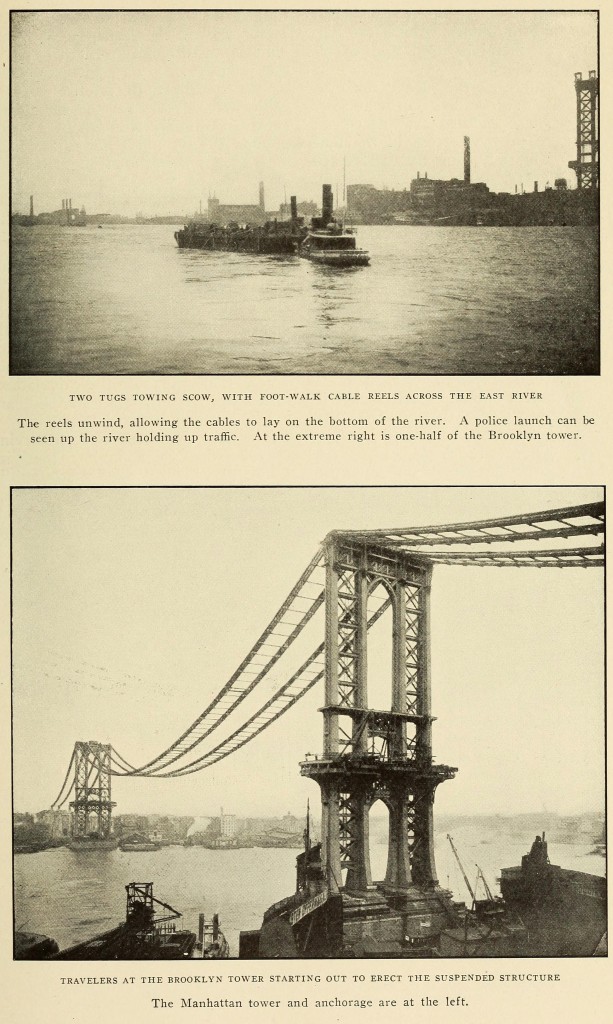Building the Manhattan Bridge

The Manhattan Bridge with a boat and airplane circa 1919
from New York, the wonder city Published 1919 by American art pub. co.
[Reprinted from Cassier’s Magazine 1912. Article by Howard R. Commings]
ONE of the most important among the vast number of great engineering structures recently built in New York City is the Manhattan Bridge. This crosses the East River about a quarter of a mile above the Brooklyn Bridge, and serves as another link to connect the two largest boroughs, Brooklyn and Manhattan, of New York City. It will afford relief for the excessive demands made on the Brooklyn Bridge, due to the extreme congestion of the passenger transportation lines between these boroughs. It includes some of the most advanced features of design, and the highest developed methods have been used for making the steel in the mills and erecting it at the site.
Plans for the Manhattan Bridge were started as early as 1898, but they have been contested between individuals, civic societies, engineers and architects. One contract was carried to the Appellate Division of the Supreme Court and declared illegal. The objections made by the court were eliminated and a new contract drawn, but again a temporary injunction was granted, and it was not until June 15, 1906, that the contract for the towers, cables and suspended structure was let.
New York City has never been able to keep up with the demands for transport facilities. When the Brooklyn Bridge was opened, on May 24, 1883, Brooklyn had a population of only 600,000. To-day it has a population of 1,600,000. Elevated railroads, as we know them, were not then in existence; nor was electricity used as a power for transportation. For six years pedestrians were charged a cent for crossing the bridge. Mr. John A. Roebling expected that the Brooklyn Bridge would carry less than ten million people per annum, but at present more than half a million cross the bridge every twenty- four hours. In 1898 the cable cars not being sufficient to accommodate the people crossing the bridge, many Brooklyn electric car lines were put on the roadways. As each roadway is only 18 feet wide, one readily sees the congestion caused by the ever-increasing vehicular traffic. The opening of the Manhattan Bridge has reduced this traffic one-half, has taken trucks away from the ferries, and besides has created a traffic of its own.
The Manhattan Bridge has eight single lines of track, four surface railway tracks on the upper deck and four elevated or subway tracks on the lower deck. The eight railway tracks will have a carrying capacity of 180,000 passengers per hour — more than double that of the Brooklyn Bridge. It has, in addition to the eight railway tracks, a roadway 35 feet wide in the clear and two sidewalks, each 12 feet wide. The total width of the bridge is 120 feet, and the total length, including approaches, 6,855 feet. The bridge extends from Canal street near the Bowery in Manhattan to Nassau street in Brooklyn. Each of the Manhattan and Brooklyn terminals will occupy two solid blocks.
The property acquired for building the bridge, besides that mentioned above, is a strip of land 160 feet wide running along the line of the bridge on each side of the river. The cost of the property condemned in Manhattan has been about $8,000,000, while that in Brooklyn cost about half as much. The section demolished in Manhattan was in the midst of the most congested district on the East Side. The buildings, though mostly tenement-houses, were substantial ones and netted the landlords a nice income. The section in Brooklyn was a poorer class of buildings and property, hence the much less valuation.
The Flatbush avenue extension, a street 120 feet wide, running from Fulton street and Flatbush avenue to the bridge, was bought with the expectation of building an elevated structure along it; but popular sentiment has changed during the past ten years with respect to elevated railways. Then they were looked upon as a ready means of relieving traffic congestion; now they are considered as a noise nuisance and an enemy to light and air. Then nine-tenths of the people wanted many additional miles of elevated railroads built; now just as large a percentage want no more elevated structures, and many fully believe that within forty years the present elevated railways will be torn down. Mr. O. F. Nichols said: “The existing elevated railways at least will always be with us, simply because we shall never be able to do without them.”
The main part of the bridge is the suspended structure, which is 2,920 feet long, that of the river span being 1,470 feet and each side span 725 feet. This is all supported on four cables, which hang in vertical planes carrying four stiffening trusses. The cables are supported by two steel towers, and are fastened at their ends to masonry anchorages. The bridge has a clearance of 135 feet aboA’e mean high water for a distance of 400 feet at the centre.
This bridge has the greatest river span, with three exceptions, of any bridge in existence. The Firth of Forth Bridge in Scotland has a span of 1,710 feet. This is of the cantilever type. The river span of the Brooklyn Bridge is 1,595 feet 6 inches, while that of the Williamsburg Bridge is 1,600 feet. The last two are of the suspension type. The next longest bridge ever built is that of the Queensboro, also in New York City, one span of which is 1,182 feet. None of these bridges nor any bridge is designed to carry the enormous amount of traffic that the Manhattan Bridge will.
The essential features of any suspension bridge are: First, the cables to support the bridge; second, the towers to support the cables, and third, the anchorages to fasten the ends of the cables. In a large suspension bridge like this the stiffening trusses to distribute the load to the cables are of no small concern. Other features, as wind bracing, the design for taking care of local strains and stresses, size and number of rivets, etc., are mere details that accompany any engineering feat, but which demand careful study and consideration.
One property of all steel structures that the public thinks little about is that of expansion and contraction, and no other property has caused more annoyance to engineers. The technical expression found in all treatises, that steel or iron expands or contracts 0.0000065 of a food per foot per 1 degree F., seems at first very small and negligible; but when one considers that our climate is so variable that it is common every year to see the mercury register o degree F. and 100 degrees F., one begins to realize that even small things count. This means one-quarter of an inch in a 30-foot rail. In walking along a railroad track the most casual observer will notice the joints open in the winter and practically closed during the summer.
In a structure 2,920 feet long a change of 100 degrees F. means a change in length of 1 foot 10 3/4 inches. This is taken care of in the stiffening trusses by a rocker post on each side of each tower. The post is 12 feet long, with a pin through each end, one end of which is fastened rigidly to the tower and the other end to the bottom of the truss. The movement may be described as being similar to that of the upper arm and bod)* when the elbow is resting firmly and the body sways, the upper arm acting as does the rocker post. One plate sliding back and forth over another one at different points takes care of the expansion in the roadwav and sidewalks. In the tracks the rails are split and slide past one another. The tower pier foundations are carried to a depth of 92 feet below mean high water. The foundation in Brooklyn rests on bedrock and in Manhattan on coarse sand and fine gravel of a very firm character, as the negligible amount of settlement which has occurred indicates. These foundations were sunk by the caisson method, and are of concrete and limestone masonry, with granite facing above mean low water. Under an extreme condition of loading — namely, with a congested load covering the entire length and width of the bridge — the pressure on the foundation of the piers will be 8.4 tons per square foot. These foundations were completed in 1904, and the same year contracts were let for the building of the anchorages.
The foundation of the Brooklyn anchorage was so satisfactory that only a few piles were driven. The Manhattan anchorage rests on sand and closely-driven piles. The anchorages, as the name implies, are to anchor the ends of the cables. The cables are divided into strands, and each strand is fastened by means of a strand shoe to a pair of eye-bars. The eye-bars are 9 inches by 1 7/16 inches carbon steel, in four lengths, making each eye-bar chain 110 feet long, all embedded in concrete, except where the strands of the cables are fastened. These eye-bars are further anchored at their lower end to large steel plate girders, which are also embedded in concrete at the rear and bottom of the anchorages. There is also steel embedded in the front of the anchorages as an anchor to the wind bracing and to give a rigid connection to the stiffening trusses. This steel, together with that anchoring the cables, weighs 2,700 tons. Besides this, there are 900 tons of steel reinforcing bars used in the construction of the anchorages themselves.
A street runs through each anchorage, necessitating an arch 46 feet wide and 45 feet high. There are 464,000 tons of masonry in the anchorages, which is more than enough to hold the cables, the extra amount of masonry being required on account of constructing the arches.
The towers to support the cables are of steel. Each tower is made up of four vertical posts or legs rigidly connected to the tower foundation pier and to each other. The bottom of each leg is 33 feet long by 5 feet wide, diminishing in size to 10 feet long by 5 feet wide at the top. This gives the towers a tapering effect and an artistic shape. Each leg was divided into thirteen lengths and each length into three parts or sections, the heaviest ones weighing 61 tons. Each section is made up of vertical and horizontal plates or diaphragms, so that every exposed surface is accessible inside, as well as outside. The sections were placed in position by a vertical traveler, a very ingenious device of the contractors. This would place one length of two adjacent legs in position, then pull itself up on this length and place the next section. The traveler, equipped, weighed 65 tons. There are three separate vertical compartments running the entire length of each leg. A ladder is placed in each compartment and a manhole cut through each horizontal diaphragm, so that one can climb easily to the top of the tower through the inside of the leg.
The saddles carrying the cables are fixed to the top of the towers, while the Brooklyn Bridge saddles are set on rollers and move under varying loads and temperature. Under an imaginary loading that would cause maximum deflection, the Manhattan Bridge towers would bend 2 feet 3 inches at the top and still be well within the safety margin. In order to have a record of the deflection of the towers, a bass piano wire is fastened in each outside leg at the top and suspends at the bottom a plumb bob weighing 20 pounds. The extent that this weight moves gives the movement of the tower at the top. At one time during the erection of the stiffening trusses this movement was as much as 8 inches, but at no time since the completion of the bridge has the movement been more than 3 inches.
The weight of the towers is 12,514 tons. The top of the cables is 322 feet and the top of the ornamental work is 336 feet above high water. Features of these seemingly slender steel towers are the speed and economy of their construction compared with the slow and costly construction of the massive masonry towers of the Brooklyn Bridge.
There is no part of a suspension bridge of more importance than its cables. To the engineer, these are simpler to design and to erect than some other parts of the structure. Each of the four cables contains 9,472 wires, laid parallel and closely wrapped to form a cylinder of 21 1/4. inches diameter, being 5 1/2 inches larger than the cable of the Brooklyn Bridge. Each wire is slightly less than /j- inch in diameter and is 3,224 feet long. The total length of wire in the four cables is 23,132 miles, which is nearly enough to reach the entire distance around the world.
Before the wires of the four cables are strung a footwalk must be built as a working platform. This is constructed of wood, resting on four small cables. Each cable is made up of four wire cables 1 3/4 inches in diameter. This makes sixteen separate I 3/4-inch cables to be carried across and suspended over the river. On one reel is a cable long enough to reach from anchorage to anchorage, passing over both towers. This reel is placed on the Manhattan tower foundation pier and one end of the cable pulled up to the top of the tower and back to the anchorage, where the end is permanently fastened. The reel, with three others similarly fastened, is next placed on a scow, and the scow is towed across the river. The reels unwind, allowing the cables to lay on the bottom of the river, which, during this process, is closed for navigation by the police patrol and United States harbour boats. The length of time that the river was closed was not over ten minutes. When the scow t and reels arrive at the Brooklyn tower the cable is taken off from one reel and the end pulled up over the tower and back to the anchorage. The cable is given such a pull as will cause it to hang about 5 feet below the position of the main cable and is then fastened to the Brooklyn anchorage. The three other cables go through the same process and then four more are brought across, and so on until the sixteen are in place. The engineers, with surveying instruments, give the location for the cables. The wooden walks or four working platforms are then built on these cables and the plant for stringing the wires of the main cables put into operation.
The equipment for work on each cable is as follows: An endless 3/4-inch hauling wire rope which is supported on sheaves held in nine equidistant small towers, passes around an 8-foot horizontal wheel in each anchorage. The wheel at the Brooklyn anchorage is driven by a 40 horse-power motor. To the rope is fastened two 4-foot vertical steel sheaves, which hold a bight or loop of the cable wire. These two vertical sheaves — called spiders, because they spin — travel back and forth over the river, spinning out four wires as they go, which unwind from reels situated on the anchorages.
The wire is made at the mill in lengths of 3,000 feet and spliced together there with right and lefthand sleeve nuts in lengths of 80,000 feet. One length is wound upon a reel. These reels are delivered at the site and mounted on an axle. The spiders take the wire direct from these reels. As soon as one is emptied another is put in its place, and a field splice similar to the mill splice is made and the process of spinning continues. The wire at the anchorage is passed over a strand shoe shaped like a horseshoe and is carried back over the bridge. There are 256 wires in each strand, amounting to really one continuous wire passed 256 times back and forth over the river from anchorage to anchorage. As each strand is completed, the strand shoe is fastened to a pair of anchorage eye-bars by a steel pin 7 inches in diameter.
In order to obtain the right pull, or tension, as it is called, on each wire, a guide wire, whose length at different temperatures is known, is placed in the same position as the strand that is to be spun. Now it naturally follows that if another wire is placed alongside of this guide wire it, too, would be the right length and have the same tension. This is the process used throughout the cable, and, though it may seem simple, it assures that each wire is doing just as much work as any other wire. It took the spider about eight minutes to run from anchorage to anchorage. The largest number of wires laid in one cable in eight hours was 218. The largest number of wires laid in the four cables in eight hours was 812. The first wire was strung on August 10, 1908, and the last one, in the presence of Mayor McClellan, on December 10, 1908. The stringing of 38,000 wires in four months shows the efficiency of methods used and excellent supervision.
The cables, as they leave the eyebars, pass over saddles on the anchorages. These saddles are placed on rollers, to prevent stress in the masonry. The saddles at the towers are each 11 feet long by 6 feet wide and 3 1/2 feet high, weighing 25 tons. This is cast in one piece and bolted to the towers, as before mentioned.
About every 18 feet along the cable a band is clamped to it. Each band consists of two semi-cylindrical concave castings; the upper part has flanges to hold the suspenders, of which there are two pairs at each cable band. The suspenders are 1 3/4-inch twisted wire rope, with ends socketed with babbit. Each socket is connected to the bottom of the stiffening truss by a nut and bearing plate. There are 1,264 suspenders which carry the load on and the weight of the bridge to the cables. Tests, made by the Bridge Department at the manufacturers, show that it takes a load of 145 tons to break one of these suspender wires. This is an ultimate strength of 215,000 pounds per square inch, the same as the specifications require for the cable wire. Tests for the cable wire show an ultimate strength of 225,000 pounds (112 1/2 tons) per square inch. This means that the strength of each cable is over 30,000 tons. Under a congested load placed in an improbable position the stress on the cable would be less than one-third of the above value. Thus it would be impossible to ever get a load on the bridge large enough to unduly stress the cable. A load that would produce the greatest cable stress would not produce maximum deflection of the towers. There are so many conditions that enter into the calculations of a suspension bridge that they cannot be discussed here.
The cable is wrapped by a serving wire between each band. This wire is slightly smaller than that used in the cables, and is wound around the cables under a stress of 10,000 pounds per square inch by a machine specially designed for this bridge, a most ingenious invention by the cable contractor’s engineer. We hear sometimes the following criticism: “It will rust out if it won’t wear out.” This does not apply at all to the cables of the Manhattan Bridge. Each individual wire is galvanized and oilcoated. The interstices or spaces between the wires are filled with a heavy grease. Then the wrapping wire excludes all moisture, and outside of this, again, is plenty of paint. The weight of the wire in the cables is 6,000 tons. The weight, including bands, suspenders and saddles, is 7,771 tons.
The stiffening trusses, one under each of the four cables, carry and distribute the loads on the floor system to the cables. These trusses are made heavy, so that the stress caused by the load at one point will be distributed over a considerable length of the cables. The main members of the trusses are made of nickel steel, even to the rivets used in these members. Nickel steel is a little more expensive, but much stronger than carbon steel. The other members and floor systems are carbon steel. The erection of the trusses was carried on by travelers working simultaneously from each tower. These travelers erected first the bottom members of the trusses and bottom floor system. The travelers on each side of the towers were then pulled back, after they had reached the centre of the river and anchorages, respectively, and proceeded again on their journeys, erecting the auxiliary members. On the next return trip back to the towers the upper floor system was put in place. No falsework was required, as fastening could be made at once to the suspenders from the cables.
The approaches, reaching from anchorage to street grade, are steel viaducts supported on six masonry piers. The viaducts are similar in Brooklyn and Manhattan. The arrangement for carrying the traffic is the same as described for the suspended structure. The steel was erected on wooden falsework by a large traveler, as shown in the illustration. The special interesting feature in the contract for the construction of these viaducts was the lowering of Sands street, in Brooklyn, 10 feet without interrupting trolley traffic and the lowering of Division street, in Manhattan, 6 feet. This latter work necessitated a reconstruction of the Second Avenue Elevated Railroad, which was done without interruption of the elevated service in either direction.
On the terminals an earth fill has been made, on which is built a temporary roadway and sidewalks leading to the approaches. No cars are crossing the bridge at present. The only thing that prevents this is the terminals. Plans for these cannot be settled until traffic arrangements are completed. The Brooklyn Fourth Avenue Subway is the only railway line that is definitely known will cross the bridge. This will take but two of the eight tracks. It is sincerely hoped by all Brooklyn that arrangements will be made in the near future for immediate use of the other six tracks by subway, trolley or elevated railways.
The sidewalks on the bridge are made of a 2-inch reinforced concrete slab, with a 3/4-inch wearing surface of mastic asphalt. This surface is the same as that usually seen in park walks, only of a different texture. The roadway is paved with wood blocks laid on planks, which are bolted to the steel. Other finishing features to the bridge are too numerous to give in detail. It might, however, be mentioned that even a single item, as the railings, is a large one. There are 11 miles of different kinds of steel railings, weighing 1,100 tons. There are over 20 miles of electric wire for lighting the bridge. The total amount of steel in the bridge is 60,800 tons, while that in the Brooklyn Bridge is 22,200 tons. The weight of the bridge per linear foot is 25,000 pounds (12 1/2 tons), and will carry an additional load of 16,000 pounds (8 tons) per linear foot. All of the details are of a very heavy and substantial character, while the general appearance of the bridge is light and graceful. One thing noticeably different from other suspension bridges is that the cables are entirely above the suspended structure. There was no engineering reason for doing this, only an architectural one.
At one time as many as 600 men were employed on the bridge. On an average over 300 men were at work continuously from January 1, 1908, to December 31, 1909. Most of the construction work was done during this time. At the first date the steel towers were only partly erected. At the latter date Mayor McClellan officially opened the roadway for the vehicular traffic. Facts and figures could be given until the reader was tired. One cannot realize the vastness of this work unless he has been familiar with similar undertakings. Suffice it to say that it would take one man, working continuously, 198 years to construct just the cables, provided that he could work to as good an advantage as several could. This is over five natural working lives.
The cost of the construction of the bridge up to the present time has been a little less than $13,000,000. The terminals will cost $2,000,000 more. To this must be added the cost of the property, which was about $12,000,000, thus making a total cost in money of $27,000,000. About twenty lives have been lost in the building of the structure. It seems pitiful that men must be sacrificed in such an undertaking, but what more beautiful monument could be erected to their memory? What would more benefit their fellow men than this monument, partly elected by themselves and for which they gave their lives?

